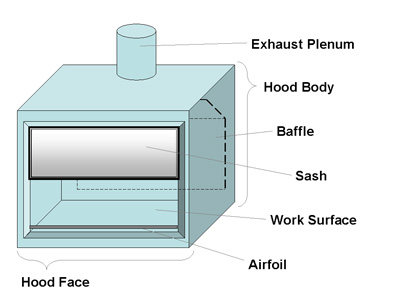Laboratory Ventilation
Laboratory fume hoods are designed to protect you from chemical or biological hazards. They are very effective if maintained and used properly. The primary parts of a fume hood are listed below:

Fume Hood Terms
- The exhaust plenum transports the fumes out of the fume hood body.
- The fume hood body contains the harmful fumes and prevents contact with the user.
- The baffle(s) are located in the back of the hood and direct air flow to the exhaust plenum.
- The sash is the movable glass partition that protects the user during operation. In some hoods, its position controls the hood face velocity.
- The hood face is the opening at the front of the hood between the sash and the work surface.
- The work surface is the area where the hazardous substances are manipulated.
- The air foil is located at the front edge of the work space below the sash. It improves the air flow efficiency by preventing the formation of turbulence eddies that can allow fumes to escape into the lab.
- Face velocity is the speed at which air flows into the hood. The minimum face velocity for a fume hood to operate properly is 100 linear feet per minute.
Fume Hood Prudent Practices
- Test before use
- Face velocity – 100 linear feet per minute
- Keep experiments
- 6-12” from front
- 1-2” from back
- Keep sash down as far as possible
- Don’t overcrowd work areas
- Notify lab manager of any problems






